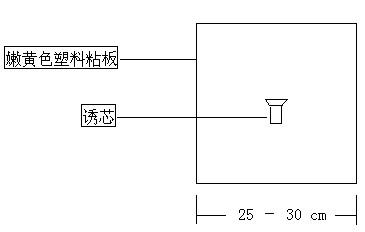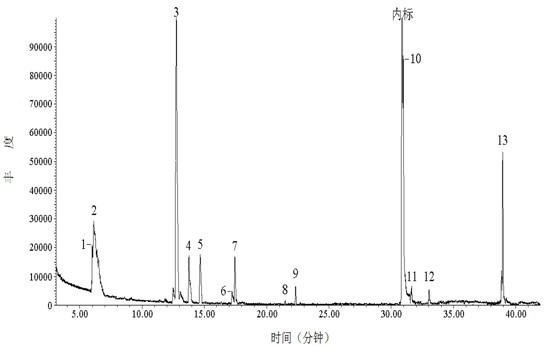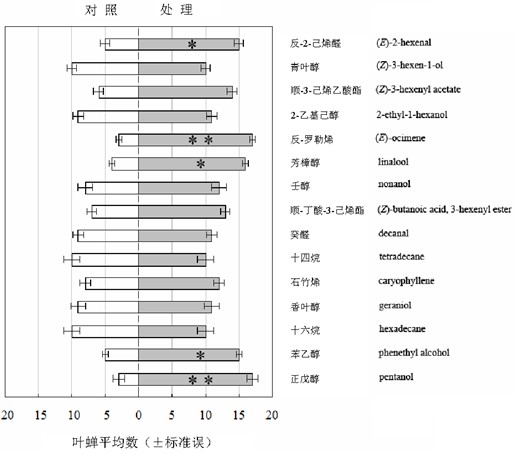Method for preventing and controlling empoasca vitis by trapping
A technique of trapping and trapping small green leafhoppers with false eyes, which is applied in pest control, botany equipment and methods, devices for catching or killing insects, etc., can solve the problems of large number of leafhoppers, heavy damage, and difficult control, and achieve Quick effect, easy operation, and reduced effect of chemical control
- Summary
- Abstract
- Description
- Claims
- Application Information
AI Technical Summary
Problems solved by technology
Method used
Image
Examples
Embodiment 1
[0018] (1) Choose healthy tea tree plants as the test material, cover them with a clean glass cover, let the clean air flow through the air inlet, entrain the tea tree smell and flow through the Super Q adsorption column connected to the air outlet, rinse the adsorption column with chromatographically pure ether, The eluate was concentrated slowly under a stream of high-purity nitrogen. The concentrated solution was analyzed by gas-mass spectrometry, qualified with standard samples, and quantified by adding internal standard ethyl caprate, and identified 13 main components in the smell of tea trees;
[0019] (2) The 3rd-instar nymph of the false-eyed green leafhopper was used as the test insect, and the 13 main components identified, as well as pentanol and phenethyl alcohol were used as the taste source, and the behavioral biometry was carried out by a Y-shaped olfactometer. The results were Indicates: amyl alcohol, - Ocimene, phenylethyl alcohol, and trans-2-hexenal were t...
Embodiment 2
[0027] (1) Isolate and identify volatiles from healthy whole tea plants and detect their attractant activity to leafhoppers
[0028] Cover the above-ground part of the potted Longjing tea tree plant with a clean glass cover, and pass the filtered clean air from the air inlet, entraining the tea tree smell to flow through the Super Q adsorption column connected to the air outlet, and dynamically absorb 8 After 10 hours, the adsorption column was removed and rinsed with chromatographically pure ether, and the eluate was slowly concentrated to about 20 μl under high-purity nitrogen flow. Draw 1 μl and analyze by gas-mass spectrometer, cooperate with standard samples for qualitative, add internal standard ethyl caprate for quantitative, and identify 13 main components in tea tree odor, see figure 2 . figure 2 In: 1 is trans-2-hexenal ( E )-2-hexenal, 2 is cis-3-hexen-1-alcohol ( Z )-3-hexen-1-ol, 3 is cis-3-hexene acetate ( Z )-3-hexenyl acetate, 4 is 2-ethyl-1-hexanol, 5 ...
Embodiment 3
[0052] For many years, chemical pesticides have been banned in the tea gardens of Gengxiang Organic Tea Company in Wuyi County, Zhejiang Province. Usually, at the end of spring tea in mid-May, the tea gardens are heavily pruned to cut off branches and leaves to suppress the first leafhopper population and the second in September. Plant-derived and mineral-derived pesticides were used when leafhopper populations were in full bloom. The pollution-free tea gardens around the company have been using chemical pesticides. Do the following control tests:
[0053] (1) Trapping test In 2010, the research group selected a piece of leafhopper in the company whose density reached the control index, with an area of 6700 m 2 The tea gardens are used as trapping areas and are not pruned. Regular field surveys showed that June 4th was the peak period of leafhopper adults, that is, the number of adults accounted for 16% of the total leafhopper population, so the new traps were loaded on ru...
PUM
 Login to View More
Login to View More Abstract
Description
Claims
Application Information
 Login to View More
Login to View More - R&D
- Intellectual Property
- Life Sciences
- Materials
- Tech Scout
- Unparalleled Data Quality
- Higher Quality Content
- 60% Fewer Hallucinations
Browse by: Latest US Patents, China's latest patents, Technical Efficacy Thesaurus, Application Domain, Technology Topic, Popular Technical Reports.
© 2025 PatSnap. All rights reserved.Legal|Privacy policy|Modern Slavery Act Transparency Statement|Sitemap|About US| Contact US: help@patsnap.com



